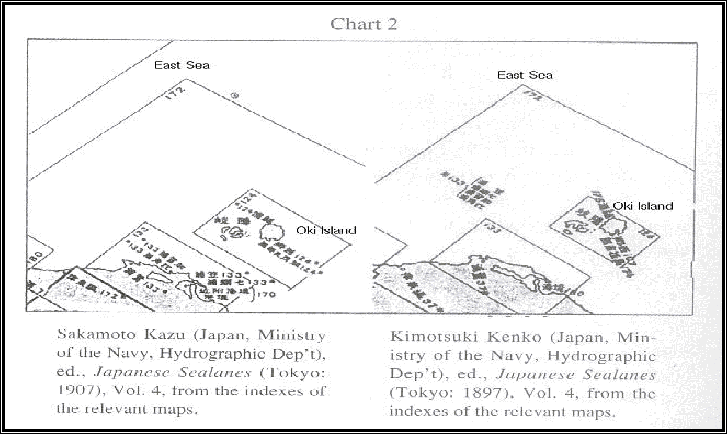The logbook of the Niitaka on September 24, 1904 reads as follows: "Koreans call the Liancourt Rocks Dokdo while the Japanese fishermen call it Lianco. It is possible to moor the vessels between the two rocks, but a small boat is usually pulled ashore. When the sea is rough and it is difficult to anchor, boats usually take refuge on Ulleungdo until the weather calms down.. Those who come from Ulleugdo to catch sea lions use a Japanese vessel that can load 60 to 70 koku (307 to 358 bushels) and build huts to stay there for about 10 days each time: The catch is plentiful: and the number of the crew sometimes exceeds 40 to 50, but they talk about the lack of fresh water..." Here in this documented log book we can see that the Koreans had been using the name Dokdo before the Shimane Prefecture inclusion. In addition, this journal proves Koreans were both cognizant and involved with the island. Thus the island was not a terra nullius as Japanese have claimed.
On November 13, 1904, the Japanese Naval General Staff ordered the warship Tsushima to inspect Dokdo and see whether it was suitable for the installation of a telegraphic station there. It was a survey to examine whether it was possible to build a watchtower there to be linked by submarine cable with Ullungdo. The Tsushima arrived at the Liancourt Island on November 20, and this was the first-ever survey of Dokdo by the Japanese government. The Tsushima´s captain reported that although there was some topographical difficulty, it was possible to build a structure on the East Islet.
The Japanese government´s interest in Dokdo at that time was only for its military value. As it was absolutely impossible to engage in construction work on Dokdo during the winter, Japan, without starting the work, faced the decisive battle with Russia´s Baltic fleet. As the seas around Ullungdo and Takeshima/Tokdo became the main sea battleground, the island´s military value came to be highly valued.
On May 27th 1905 the Japanese Navy engaged and obliterated the Russian Baltic Fleet in what was known as the Battle of Tsushima. As the seas around Ulleungdo and Dokdo were the main sea battleground it became even more clear Dokdo had significant military/strategic value. Not coincidentally, the Japanese Navy drafted a comprehensive plan for facilities in the East Sea (including both Ulleungdo and Dokdo) three days later on May 30th 1905.
The warship Hashitade was ordered to go to Dokdo for a more detailed survey. The watchtower on Ulleungdo started on July 14th 1905 and was completed on August 16th while that on Dokdo began on July 25th and was completed on August 19th. In 1905, a network of military communication lines were completed from the Korean mainland-Ulleungdo-Dokdo-Matsue Japan.
Japanese Naval Publications
There are other references from the Japanese Imperial Navy such as the "Sealanes of the World" publications that also make references to the Korean name "Dokdo" in the early 1900s. The 1907 edition states: "Takeshima (Liancourt Rocks) The Koreans call this island Dokdo and Japanese fishermen, Liancoto. When the warship Tsushima surveyed this island November in the 37th year of Meiji (1904) there were small thatched huts for fishermen on the East Islet but they were said to be destroyed by wind and waves. Every summer dozens of people come from Ulleungdo to catch sea-lions. They build huts on this island and stay there for about 10 days each time."

These Japanese naval maps showing Japan´s territorial waters excluded Dokdo/Takeshima (from Korea Observer)